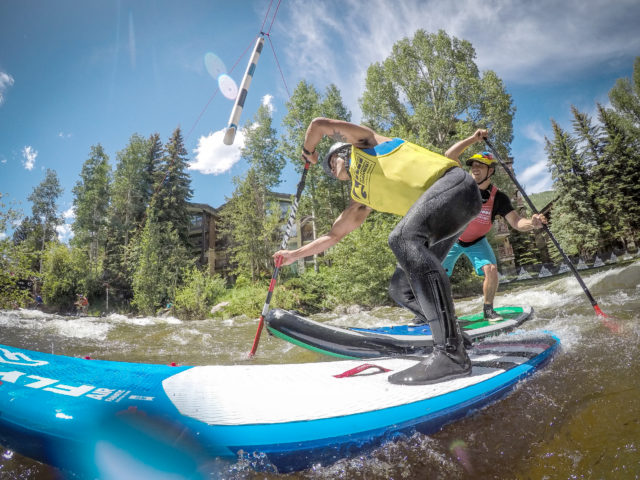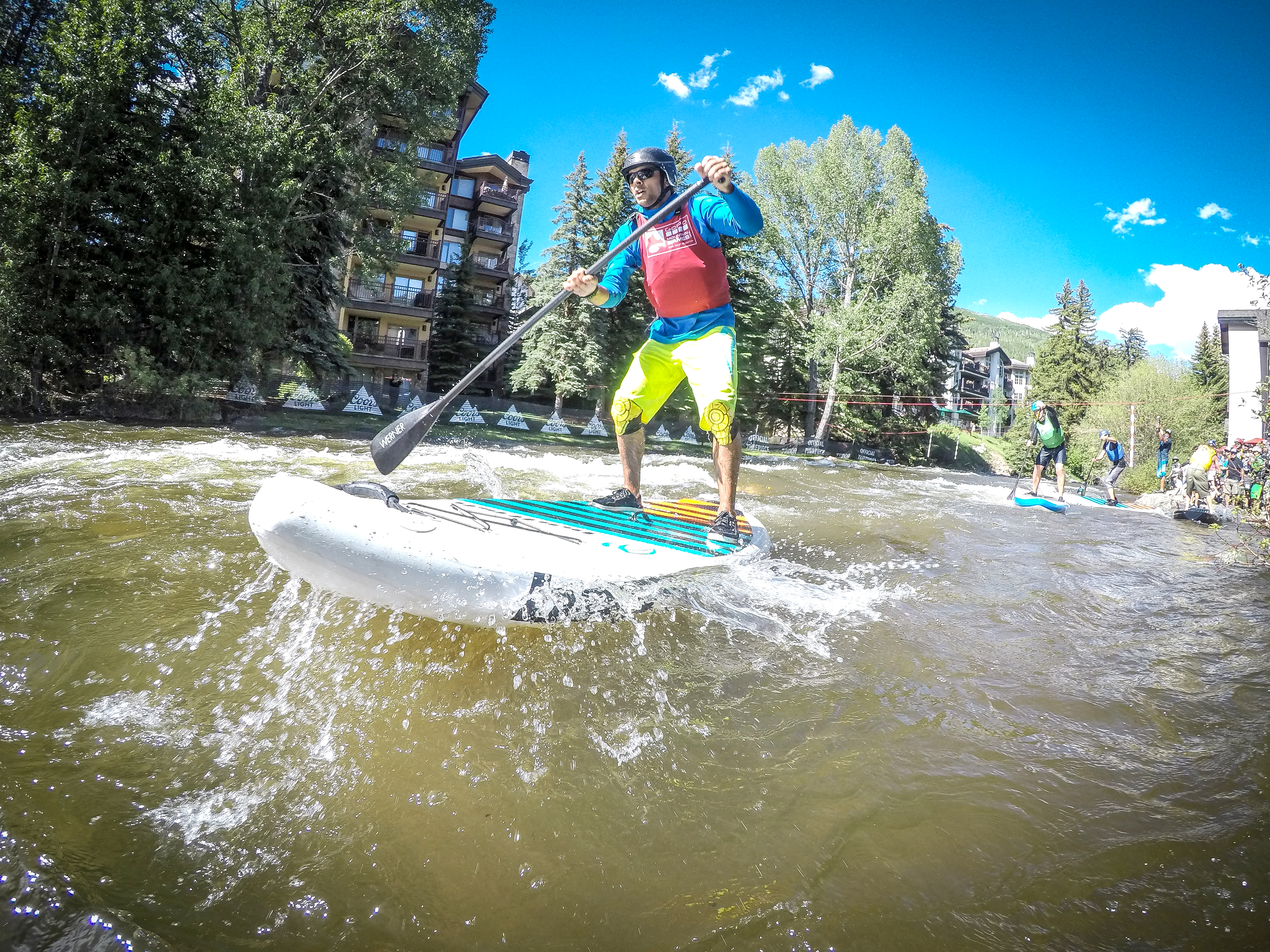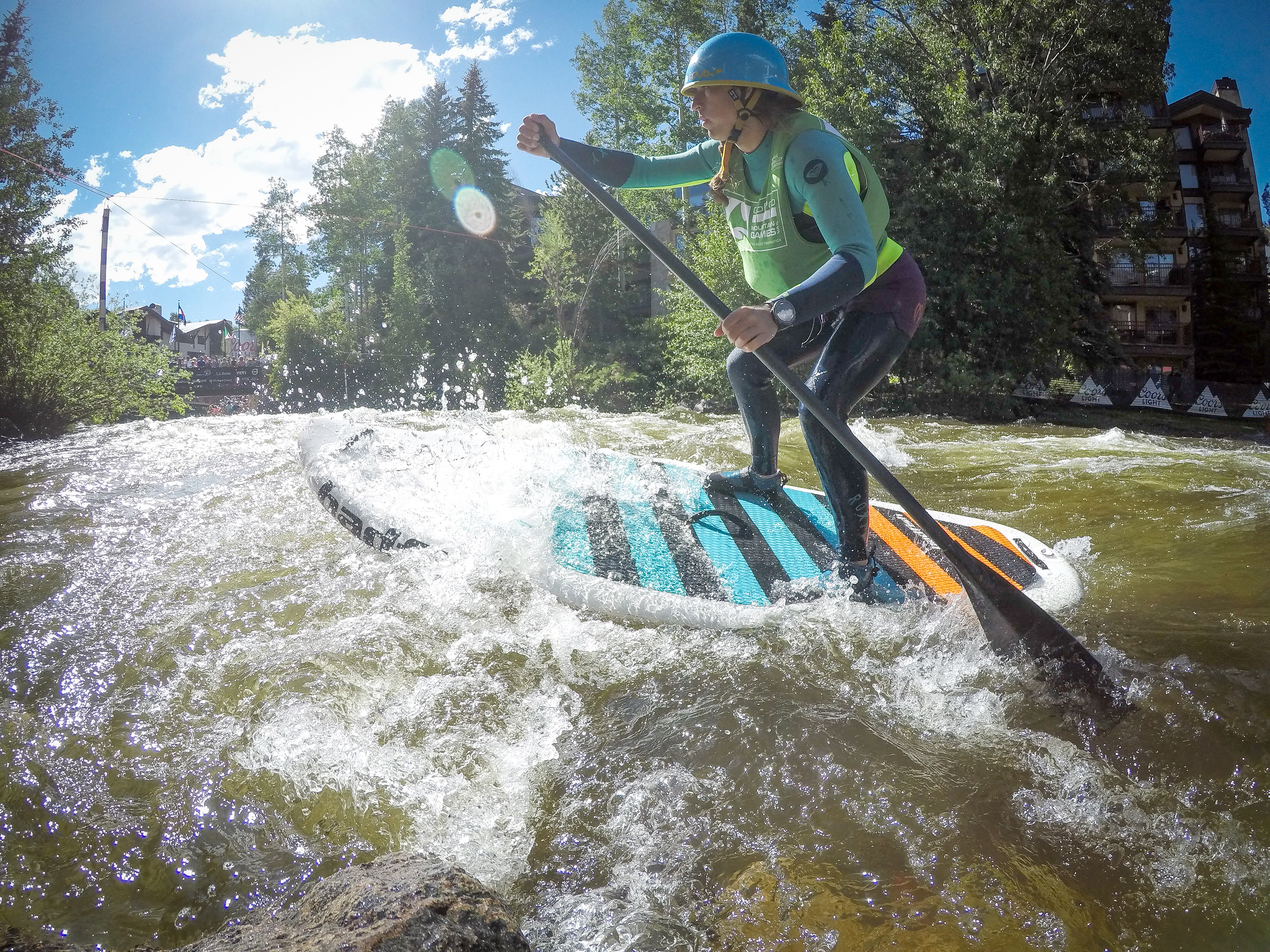
It’s a hot and sunny weekend in Vail, the first real weekend of the summer, with temperatures that nearly make you wish for the frozen days of January, if only to cool off a bit. But the guys and girls on Gore Creek aren’t too hot. The water is swollen with snowmelt and it’s icy and cold and running fast. It’s a perfect day to be out there chasing the rapids and eddies. But these watermen aren’t in kayaks, they’re on stand-up paddleboards, or SUPs, and they’re having the time of their lives and wowing the crowds on the edge of the stream as they careen down rapids and bounce off rocks.
The inclusion of SUP events at GoPro Mountain Games, a festival of action and adventure sports like rock climbing, mountain biking and trail running, is only one of the many visible manifestations of the explosive growth of SUP. And, despite the intensity of the display in Vail, SUP is a sport that is inexpensive and easily accessible — neophytes don’t have to brave the rapids of Gore Creek, they can paddle the calmer waters of Boulder Reservoir or float down flatter sections of the Colorado River.
“Almost anyone can do it,” says Tyler Calloway, director of business development for Surf Hardware International and board member for the Stand Up Paddle Industry Association. “The key is that you don’t need wind, you don’t need snow. Almost everyone has access to a lake or a lazy body of water. It’s open to all about as much as any sport can be.”
This accessibility has meant that the sport has enjoyed explosive growth. In 2015, SUP had approximately 2.8 million participants, many of them in landlocked regions like Colorado, far from the sport’s oceanic origins. And, while it’s almost a given that most of these people started on flat water, many of them quickly graduated to bigger challenges. In Colorado, that means whitewater.

“Everyone can get in at a basic level as they learn what they can do. They realize how much fun it is and how much farther they can take it,” says Tom Boyd, spokesman for the GoPro Mountain Games. “Someone from Iowa or Florida can come out here and try Class I, and then Class II or Class III whitewater.”
And, according to Boyd and Calloway, it’s easy to develop the skills to move up to bigger challenges because the equipment is so good.
“When buying a paddleboard, if you are not sure you are going to like it, rent and take a lesson,” Calloway says. “If you think you like it, buy a decent board from a reputable retailer who has been around; get their input. You will get a better product and you will have a better experience. That’s one of the most important things.”
“The boards are getting better and the equipment is getting better,” Boyd adds. “The pioneers of this sport are doing a great job improving the equipment so the novice will have an easier time figuring it out.”
Boyd has a point. Things are better today, especially when it comes to SUP.
Experts usually point to Hawaii as the birthplace of modern-day SUP. Sure, there are examples of people standing in canoes in Africa and paddling, as well as the traditional reed boats of Peru, paddled standing up by fisherman and estimated to have been in use for thousands of years. There are also the Venice gondolas, which feature a stand-up method of propulsion using a pole instead of a paddle. But, Calloway says, contemporary SUP “came from the Waikiki beach boys.”
Canny entrepreneurs according to Calloway, these watermen of the ’40s and ’50s would “take a paddle and stand up on one of their surfboards and go out wearing a camera around their neck to take photos of tourists surfing to sell to them. They didn’t have waterproof housings for the cameras, so that’s how they kept them dry.”
But it wouldn’t be until the 1990s when SUP would take on a life of its own, courtesy of the living legend Laird Hamilton. Hamilton was an immensely talented surfer who pioneered tow-in surfing on monster waves using jet skis and modified surfboards with straps for foot placement and security. He started playing around with large, tandem surfboards, standing up and paddling around the Hawaiian coast he called home with fellow big-wave surfer Dave Kalama in the late 1990s. By 2001, Laird had developed a specialized paddle for the activity (canoe paddles being used previously), and the modernization of SUP was on its way, with sport-specific board designs and other gear quick to evolve.
Of course, this evolution didn’t come without controversy, particularly when it came to catching waves. In places like Southern California, as Calloway notes, “good waves are a limited resource.” The ability of SUP practitioners to outmaneuver surfers and catch numerous swells led to friction, including SUP bans at San Clemente’s legendary San Onofre surf spot, where stand-up paddleboarders have been relegated to a small, fickle break called Dog Patch at the southern end of the zone. Even Hamilton, despite his impressive surfing resume, has been criticized for promoting SUP, although he deflects that by pointing out that SUP existed in its historical forms along with surfing for many, many years.

In Colorado, though, the battles over surf breaks and wave protocols don’t apply. Here it’s about whitewater, and given this year’s plentiful runoff, there’s plenty to go around. And the potential and appeal of SUP is obvious and welcomed by those involved in action sports, even if, like Boyd, they’re kayakers. “We were one of the first events to incorporate SUP,” Boyd says. “It appeals to people because they want to kayak but they don’t want to get into a boat. It’s a much more natural thing to be standing there in an athletic stance, having fun on the river. SUP has opened up river sports to so many people.”
Looking at the crowds watching the show at the GoPro Mountain Games, it’s obvious that people dig it. This year, 179 people competed in the Yeti Downriver Surf Sprint, a timed downwater race on Gore Creek that covers three miles of mixed whitewater ranked up to Class III from East Vail to the Vail Village. This is way more than those who signed up for a similar downriver kayaking event also held during the weekend. “It’s our biggest whitewater event,” Boyd says.
It’s also one of many SUP competitions across the state, from flatwater races at Chatfield Reservoir to Denver’s South Platte River Festival to Get the Girl Out Paddle Jam in Frisco on Lake Dillon.
But for truly extreme SUP, the ocean is still where the sport is breaking boundaries and pushing the limits. This ranges from races like the Red Bull Heavy Water, an elite event for the world’s best that traverses a 7.5-mile, open water course featuring 10-foot waves, sharks and other hazards, to surfing waves at monster breaks on off-shore reefs. While this sounds slightly scary for landlubbers in Boulder, don’t worry. It’s almost always calm paddling for anyone who wants to give SUP a go out at Boulder Reservoir.














